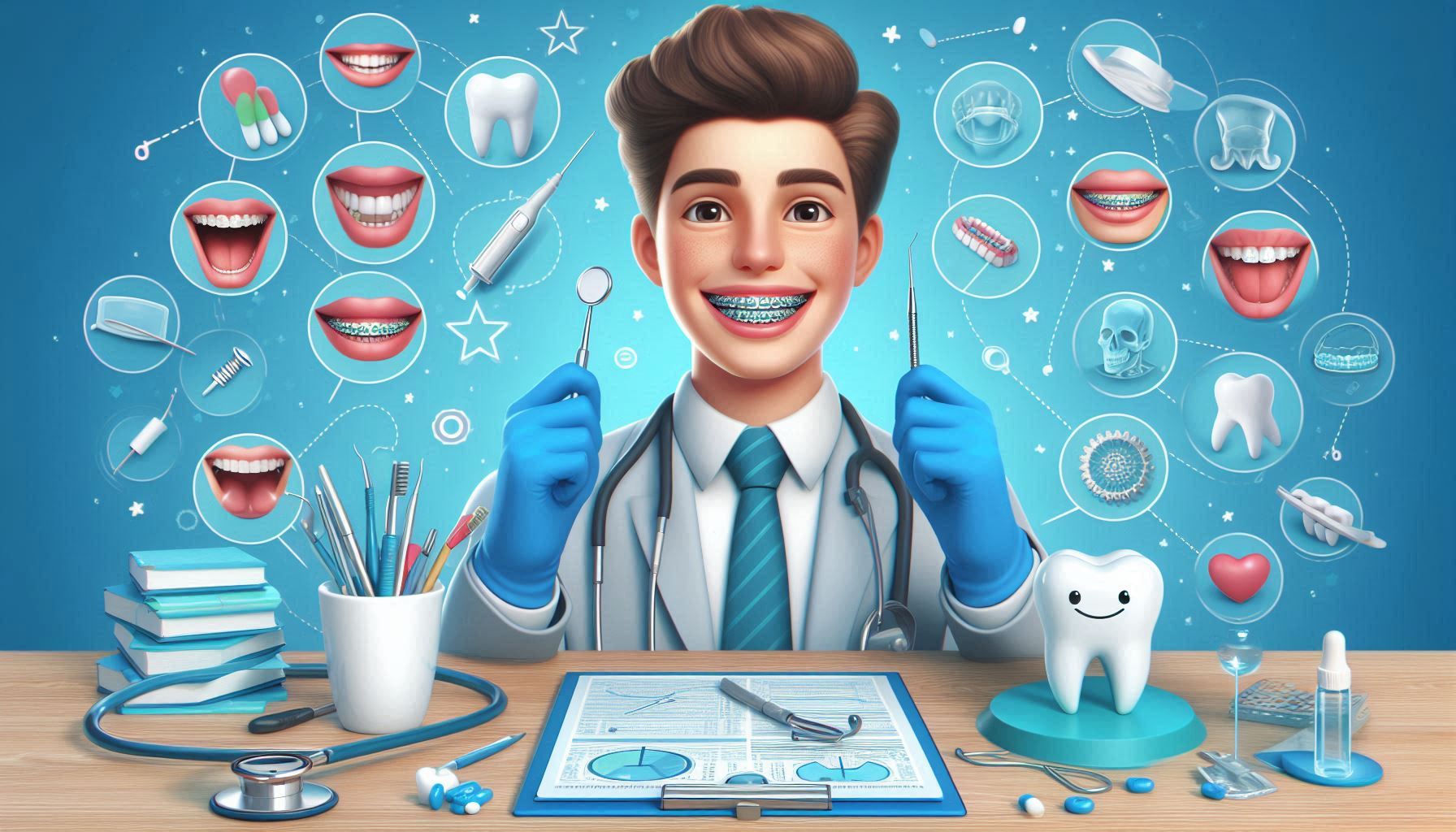Orthodontic treatment is often viewed solely as a cosmetic procedure to straighten teeth, but it goes beyond just aesthetic improvements. Proper alignment of the teeth, jaw, and bite has significant health benefits that can enhance overall well-being. In this article, we will explore in detail how orthodontic treatment contributes to oral health, functionality, and even broader aspects of general health.
Improved Oral Health
One of the primary benefits of orthodontic treatment is its impact on oral health. Misaligned teeth and jaws can create several oral health problems, some of which may require more invasive treatments if left untreated.
Prevention of Tooth Decay
When teeth are crooked or overcrowded, it becomes difficult to clean the surfaces of each tooth effectively. Even with diligent brushing, some areas may not be reached properly, leaving plaque and bacteria behind. Over time, this can lead to tooth decay and cavities. Orthodontic treatment can reposition teeth to ensure they are easier to clean, reducing the risk of decay.
In cases of significant crowding, it’s often harder to floss and reach the interdental spaces. When the teeth are properly aligned, the gaps between teeth become more accessible, improving the ability to keep them clean and preventing plaque buildup.
Prevention of Gum Disease
Misalignment can also make it difficult to clean the gums properly, especially in areas where teeth overlap or are widely spaced. Gum disease (or periodontal disease) is an infection of the tissues that surround and support the teeth. When oral hygiene becomes difficult due to misaligned teeth, plaque and tartar buildup along the gumline leads to gum inflammation and infection.
By correcting alignment issues, orthodontic treatment ensures that gums stay healthier, reducing the risk of gingivitis, periodontitis, and other gum-related problems.
Better Oral Hygiene
Straightening teeth improves a person’s ability to maintain good oral hygiene. The more accessible the teeth are, the easier it is to clean them, and the better the chance of keeping plaque and food particles from accumulating. Orthodontic treatment also eliminates the need to contort your toothbrush or floss to clean hard-to-reach areas. Once the teeth are aligned properly, brushing and flossing become far more efficient, making it easier to maintain oral health in the long term.
Reduced Risk of Tooth Wear
Teeth that are misaligned can cause uneven wear on the enamel, which is the protective outer layer of the tooth. Over time, this can lead to tooth erosion, increased sensitivity, and even cracks or fractures. When the bite is corrected through orthodontic treatment, the pressure exerted on each tooth becomes more even, which helps prevent excessive wear on certain teeth.
Enhanced Functionality
Orthodontic treatment goes beyond cosmetics and is crucial for improving the overall functionality of the mouth, including chewing, speaking, and jaw movement. These functional benefits contribute to better overall health.
Correct Bite
One of the key objectives of orthodontic treatment is to correct bite problems, such as overbite, underbite, crossbite, or open bite. A proper bite ensures that the upper and lower teeth align properly when the mouth is closed, allowing for efficient chewing and reduced wear and tear on the teeth. Bite problems can lead to uneven stress on teeth, which can cause pain, discomfort, and damage to the teeth and jaws.
Orthodontic treatment realigns the teeth so that they fit together better, promoting better chewing efficiency and protecting the teeth from unnecessary stress and damage.
Improved Chewing and Speaking
Crooked teeth or jaw misalignments can impact a person’s ability to chew food effectively. For instance, if teeth don’t meet properly, chewing may be uneven, requiring more effort and possibly causing jaw pain. An improper bite can also lead to the premature breakdown of teeth due to uneven pressure distribution during chewing.
Orthodontic treatment can correct the bite and make chewing more efficient and comfortable. For some people, orthodontic work can also improve their ability to speak clearly. Misaligned teeth or jaws can impact pronunciation, and adjusting them can result in clearer speech and better communication.
Reduction in Jaw Pain and Discomfort
Misaligned teeth and jaws often lead to muscle strain in the jaw area, which can result in pain, discomfort, and headaches. This is especially common for people who suffer from temporomandibular joint (TMJ) disorders. Orthodontic treatment can alleviate jaw pain by ensuring that the teeth and jaws are aligned properly, reducing strain on the muscles and joints.
For individuals with TMJ disorders, realigning the teeth and jaw through orthodontics can help reduce symptoms such as jaw clicking, headaches, and neck pain. The treatment may even eliminate the need for more invasive interventions like surgery.
Improvement in TMJ Function
Understanding the TMJ
The temporomandibular joint (TMJ) is the joint that connects the jawbone to the skull. It is responsible for the movements of the jaw during speaking, chewing, and swallowing. Misalignment of the teeth and jaw can place additional strain on the TMJ, leading to discomfort and dysfunction.
Impact of Misalignment on TMJ
When the teeth are not aligned properly, it can cause the jaw to shift or move unevenly during regular activities like eating and talking. This misalignment can lead to TMJ disorders, which often manifest as jaw pain, difficulty opening the mouth, headaches, earaches, and even tinnitus (ringing in the ears).
Orthodontic Treatment for TMJ Disorder
Orthodontic treatment aims to alleviate these symptoms by repositioning the teeth and jaw to ensure that the bite is properly aligned. When the teeth and jaw are in alignment, the stress on the TMJ is reduced, leading to fewer symptoms and better function. In some cases, correcting the bite can completely resolve TMJ-related discomfort.
Long-term Health Benefits
Orthodontics offers significant long-term health benefits, many of which are not immediately obvious but can have profound effects on quality of life and overall well-being.
Improved Digestion
The process of digestion begins with proper chewing. If teeth are misaligned, it can cause inefficient chewing, which results in larger food particles being swallowed. These particles are harder for the stomach to digest, which may lead to digestive issues such as indigestion and bloating.
Orthodontic treatment can correct bite issues and improve chewing, ensuring that food is broken down into smaller particles, which are easier to digest. This can contribute to better overall digestive health and prevent gastrointestinal discomfort.
Preventing Future Dental Issues
By addressing misalignment early, orthodontics can prevent future dental problems that would otherwise require more expensive and invasive treatments. For example, improperly aligned teeth are more prone to cavities and gum disease, as they can be harder to clean. Treating alignment issues can reduce the need for fillings, root canals, and gum treatments later on.
Better Posture and Alignment
The position of the teeth and jaw can affect the posture and alignment of the entire body. When the teeth and jaws are misaligned, it can lead to compensatory postural changes that affect the spine and neck. These issues can cause long-term discomfort, including back pain and tension in the shoulders and neck.
Orthodontic treatment helps to achieve better overall alignment, which can have a positive impact on posture and reduce associated discomfort.
Improved Respiratory Function
A misaligned bite or jaw can also affect breathing. For example, conditions like sleep apnea can be exacerbated by jaw misalignment. Correcting the position of the jaw through orthodontic treatment can help open up airways and improve breathing, particularly during sleep. This can lead to better sleep quality, reduced snoring, and a lower risk of sleep-related breathing disorders.
Psychological and Emotional Benefits
The impact of orthodontic treatment on psychological and emotional well-being should not be underestimated. For many people, having straighter teeth improves their self-esteem and boosts their confidence.
Improved Self-Esteem
People with crooked or misaligned teeth often feel self-conscious about their appearance, which can affect their confidence in social situations. The desire to have a beautiful smile is a common motivator for seeking orthodontic treatment, and achieving a straighter smile can have a profound impact on a person’s self-esteem.
Orthodontics not only enhances the appearance of the smile but also boosts confidence in other aspects of life, such as career opportunities, social interactions, and public speaking.
Increased Confidence
A beautiful, well-aligned smile can make a person feel more confident and comfortable in their appearance. People often feel more at ease smiling in public, speaking with others, and participating in social activities. This newfound confidence can have a positive effect on personal and professional relationships, enhancing overall well-being.
Emotional Well-being
In addition to the aesthetic and social benefits, orthodontic treatment can also contribute to better emotional health. By addressing alignment issues and improving self-esteem, orthodontic treatment can reduce the anxiety and stress that people often experience when they feel self-conscious about their teeth.
Preventive Benefits for Children and Adolescents
Orthodontic treatment isn’t just for adults—it can have a major impact on the growth and development of children and adolescents.
Early Detection of Problems
Orthodontists are skilled at identifying potential alignment issues early, even in young children. By starting treatment early, many problems can be addressed before they become more serious or require extensive intervention. This proactive approach to dental care helps prevent more complex issues in the future.
Growth and Development
The early years of a child’s life are crucial for the proper growth and development of the teeth and jaws. By guiding the growth process, orthodontics ensures that the teeth and jawbones develop properly, which can prevent more complicated issues later in life.
Managing and Preventing Severe Malocclusions
Severe malocclusions (misalignment of the teeth and jaws) can cause issues such as difficulty chewing, speaking problems, and even breathing problems. Early intervention allows orthodontists to correct these issues before they become more difficult to treat, helping to manage the development of severe problems and prevent more invasive treatments in adulthood.
Conclusion
Orthodontic treatment is far more than just a cosmetic enhancement; it is a vital part of maintaining overall oral health, functionality, and well-being. The benefits extend beyond a beautiful smile and involve significant improvements in oral hygiene, bite alignment, digestion, and even psychological health. Correcting misalignment through orthodontics provides long-term benefits that affect an individual’s general health and quality of life. The improved oral health achieved through orthodontic treatment, such as reduced risks of tooth decay, gum disease, and tooth wear, cannot be overstated. These health improvements lead to fewer dental visits for restorative procedures and a reduction in future dental issues. People with straight teeth are more likely to maintain excellent oral hygiene habits, which are fundamental in preserving not only their teeth but also their gums, jaw joints, and overall mouth health.
Functionality improvements, including better chewing and speaking, may seem subtle, but they have a profound impact on daily living. An improved bite ensures that the forces exerted on the teeth and jaw are more evenly distributed, preventing excessive wear, jaw pain, and discomfort. For individuals suffering from temporomandibular joint (TMJ) disorders, orthodontic treatment can offer significant relief by aligning the bite, reducing strain on the TMJ, and alleviating associated symptoms such as jaw pain and tension. The long-term health benefits of orthodontics are profound as well. The correction of dental misalignments can lead to better digestion and respiratory function, especially by improving chewing efficiency and opening the airways for better breathing. By addressing misalignments early on, orthodontics helps to prevent a host of future dental issues, contributing to more affordable and manageable dental care in the future. Additionally, realigning the teeth and jaw can improve posture, reducing neck and back pain caused by misalignment of the upper body. The psychological and emotional benefits of orthodontic treatment are undeniable. Achieving a straighter smile can enhance self-esteem and confidence, positively influencing social and professional interactions. Individuals with aligned teeth often feel more comfortable smiling, speaking, and engaging with others, which leads to increased happiness and emotional well-being. The positive shift in confidence and self-image can also have broader impacts on mental health, reducing anxiety and boosting overall quality of life.
Finally, for children and adolescents, orthodontic treatment offers early detection of potential alignment issues, allowing for timely intervention. This helps ensure that growth and development proceed without significant obstacles, preventing more serious complications that could arise later in life. Early treatment can also minimize the need for more extensive and invasive interventions in adulthood, promoting healthier development overall. Orthodontic treatment’s benefits clearly extend far beyond aesthetics, offering a wealth of physical, functional, and emotional improvements. For those considering orthodontic care, it’s important to view the process as an investment in long-term health, not just a pursuit of a perfect smile. By understanding the holistic advantages that orthodontics offers, individuals can make informed decisions about their treatment and experience significant improvements in their lives, both now and in the future. Orthodontic care is a powerful tool for achieving better oral health, enhanced functionality, improved self-esteem, and greater overall well-being. Whether seeking treatment for aesthetic reasons or to address more serious functional issues, orthodontics plays a key role in shaping a healthier, more confident future. Embrace the benefits that come with orthodontic treatment, and unlock a lifetime of improved health, comfort, and happiness.
SOURCES
Gremillion, H. A. (2005). The impact of orthodontic treatment on oral health. Journal of Clinical Orthodontics, 39(1), 8-13.
Proffit, W. R., Fields, H. W., & Sarver, D. M. (2013). Contemporary orthodontics (5th ed.). Elsevier.
Dummer, P. M. H., Binks, J. S., & McGrath, C. (2006). The role of orthodontic treatment in the prevention of dental disease. European Journal of Orthodontics, 28(2), 169-175.
Kusy, R. P., & Whitley, J. Q. (2012). The effect of orthodontic treatment on the morphology of the teeth and jaws. Seminars in Orthodontics, 18(2), 63-70.
Devasagayam, D., & Bedi, R. (2005). Orthodontics and its role in oral health. Dental Clinics of North America, 49(2), 375-380.
Sampath, P. S., Narayana, G., & Ravindra, S. (2015). Impact of orthodontic treatment on the quality of life. Journal of Clinical Orthodontics, 49(12), 763-769.
Kapur, R., Dhingra, R., & Soni, A. (2010). Orthodontics and overall health: Addressing the psychological and physiological benefits. International Journal of Orthodontic Therapy, 16(4), 123-130.
Bennett, J. L., & McLeod, R. R. (2009). The relationship between orthodontics and temporomandibular joint disorders. Journal of Orthodontic Research, 27(3), 112-119.
Kwon, S. Y., Choi, S. H., & Kim, Y. K. (2017). A longitudinal analysis of the effects of orthodontics on dental function and TMJ health. American Journal of Orthodontics and Dentofacial Orthopedics, 152(2), 207-215.
Koh, J. K., Hwang, H. S., & Lee, S. J. (2018). Orthodontics for improving sleep apnea and respiratory function: A systematic review. European Journal of Orthodontics, 40(3), 254-262.
HISTORY
Current Version
February 13, 2025
Written By:
SUMMIYAH MAHMOOD




